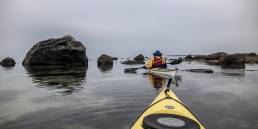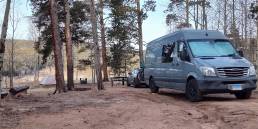The late 1860s to early 1870s was a pivotal moment in the history of outdoor recreation in the White Mountains—the region was transitioning from an era of traveling by horse on bridle paths to moving on trails by foot. One person largely responsible for this momentous shift is Joshua Huntington. While Huntington today is best known for the winter he spent on Mount Washington (and the ravine on the mountain named after him), it was the two winter months he spent on Mount Moosilauke the prior year that set the stage for his future successes and showed what was possible in New Hampshire’s mountains.

The Geological Survey of New Hampshire
As John H. Spaulding noted in his 1855 book, Historical Relics of the White Mountains: Also, a Concise White Mountain Guide, “As yet, there are many deep glens and wild crags in all this mighty pile of mountains, where the explorer had never left the print of his feet upon the moss.” It wasn’t until 13 years later, in 1868, that an attempt was made to fill in the blank parts of the map—when the New Hampshire legislature authorized a geological survey of the state.
The geological survey of New Hampshire was led by Charles Hitchcock, the state’s geologist and a Dartmouth professor. Supporting Hitchcock were his two principal assistants, George L. Vose and Joshua H. Huntington.
Unlike Vose, whose tenure on the survey was short, the geological survey of New Hampshire would propel Huntington into the spotlight and create a close association with the White Mountains that has lasted more than a century and a half. The first hiker-focused guide book (A Guide to the White Mountains, by M.F. Sweetser), credits its text to explorations made by Huntington and the author. Described as “flamboyant, imaginative, always proposing and executing brilliantly the daring stroke,” it was on Mount Moosilauke that Huntington began to earn his reputation.
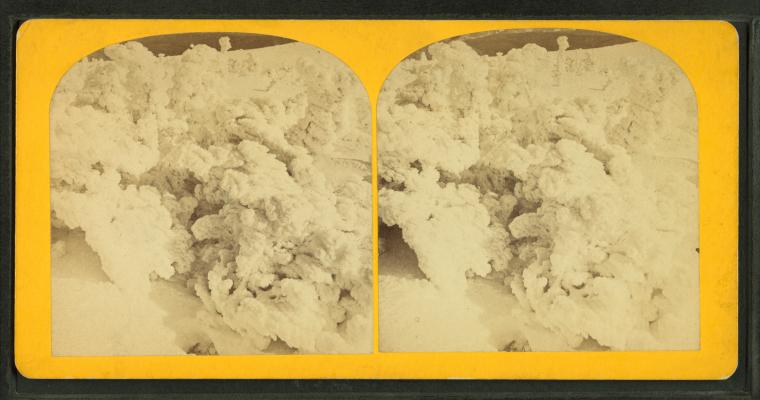
Mount Washington Dreams
As far back as 1856, Huntington (then a college student) was contemplating spending a winter on Mount Washington, observing the mountain’s fierce weather. But when the owner and lessee of the Tip Top House and Summit House denied his 1869 request to use their facilities for the winter, Huntington put his dream of a Washington expedition on hold and headed west to Mount Moosilauke. There he accepted William Little’s offer to overwinter in the Prospect House on the summit of Mount Moosilauke.
Built by Darius Swain and James Clement in 1860 on the summit proper of Mount Moosilauke, the Prospect House was a stone hotel modeled after the Summit House on Mount Washington. Its stone foundations are still visible on the summit today. And it proved to be an ideal venue to make the first attempt at spending a winter atop one of the higher summits in the Northeast.
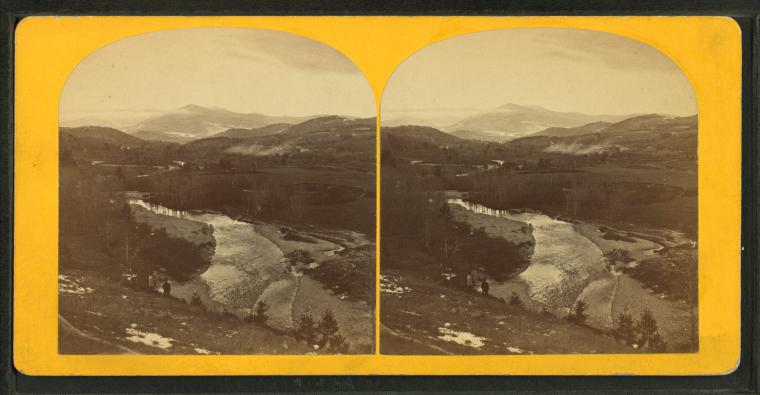
Mount Moosilauke and Huntington
Standing “nearly five thousand feet high, and within the arctic zone of climate,” Moosilauke proved to be the perfect training ground for Huntington’s future winter endeavors, allowing him to gain first-hand experience with the challenge of surviving the Whites in winter. It also treated him to one of the finest views in the region—as Huntington writes in Mount Washington in Winter: Or the Experiences of a Scientific Expedition Upon the Highest Mountain in New England, 1870-1871, “There is scarcely a mountain in New England from which the view is more extensive.”
It also gave him plentiful hands-on experience dealing with Whites’ disruptive weather. In late November, as he began to provision the Prospect House for his upcoming stay, a supply party was “met with such a blast of wind, with driving snow,” along the upper mountain ridge “that [they] were forced to halt” a mile from the summit, likely just past what is known as Moosilauke’s South Peak today. Between the wind and the “immense” snowdrifts that blocked the trail and prevented the horses from moving forward, the party ultimately had to retreat. The withdrawal left some in the supply party “in agony with frosted feet; some, if their ears were not frozen, suffering in pain from the effects of the cold, while others were lame from their severe efforts climbing the mountain.”
It wasn’t until late December that Huntington had the Prospect House ready with firewood, food, and meteorological instruments on loan from the Smithsonian Institute for his (and photographer Amos Clough’s) two-month stay on Moosilauke’s summit. And it was not without further encounters with the White Mountains’ fierce weather. On one of the final supply trips, the cold was so intense and the wind blew so hard that it was difficult to breathe, nearly blowing several men in the supply party over the crest of the ridge.
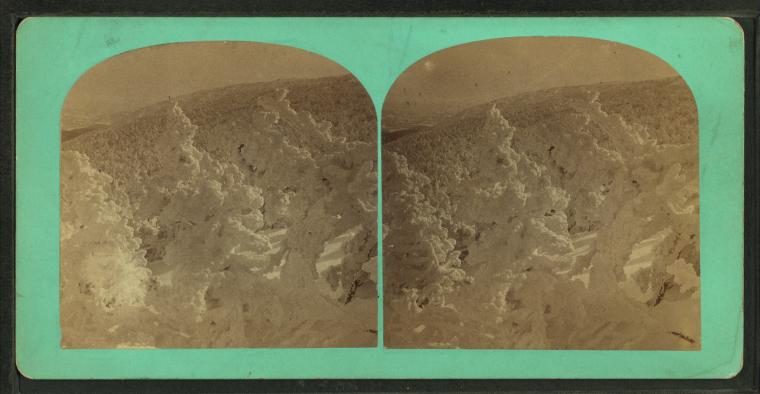
Life on Moosilauke’s Summit
With the Prospect House fully stocked, on December 31, 1869, Huntington and Clough began their stay on the summit. After the challenges of provisioning the expedition, you can imagine Huntington and Clough breathed a sigh of relief when “the sun rose clear” after their first official night on the mountain. Unfortunately, for Huntington and Clough, it was the calm before the storm, and the following day brought with it “a perfect tempest.”
Determined to measure the storm’s intensity (after all, the main purpose of the expedition was to measure the mountain’s winter weather), Clough found a position protected enough from the gale to take a measurement of the wind with an anemometer. He recorded it as blowing at 97.5 mph, at the time the fastest wind speed ever recorded. When Clough made it back to the safety of the Prospect House, he was “thoroughly saturated, the wind having driven rain through every garment.” The duo then spent the rest of the afternoon sheltered in the Prospect House, as the storm drove rain through the building’s “every crack and crevice,” flooding the floor of their room.
Over the ensuing two months, Huntington and Clough spent their days observing the weather. They observed how the mountain interacted with approaching fronts, how a rainstorm had encased the upper mountain in ice, and how two weeks of February snows created a winter scene of “extraordinary brilliance and magnificence” that they believed could “probably never be surpassed.”
More granularly, their detailed temperature observations demonstrated that the average temperature on the summit was eight to ten degrees colder than at the base, as well as a lot windier. Clough also photographed numerous new forms of frost. Perhaps most significantly, they also disproved the existence of so-called “frost clouds,” which some believed would make the summit inhospitable for human habitation in the winter.
On days when the weather was calm, the two explored the upper mountain’s various geographic landmarks. Most remarkable to them—a “grand feature in the scenery”—was the ice that developed in the upper reaches of the Baker River as it spilled through an immense gulf northeast of the summit (presumably today’s Jobildunk Ravine). They found ice columns up to 30 feet in height as well as an ice cavern of “wondrous beauty.”
A Successful Stay
Near the end of February, with their firewood supplies dwindling and temperatures ranging from 0 to -17°F, Huntington and Clough decided it was time to leave the Prospect House and head back to civilization. Much like their supply missions, their descent was beset by high winds from the west.
Having loaded their supplies onto a sled, Huntington and Clough first slid down the upper mountain’s southeast slope, which for the time sat in the lee of the wind. As they traversed southwest toward the ridge for the Carriage Road, the duo was blasted with a wind so strong that their sled was dashed against a rock and disabled. Eventually, Clough was able to obtain a second sled, the two loaded their gear onto it, and they were able to make it across the ridge and into the safety of the woods below.
By the time they reached the town of Warren later that day, the pair had spent over two months on Moosilauke’s summit. This “brief stay” demonstrated that it was possible for people to survive a winter on a high mountain summit in New England. And as they would later recollect, their stay gave them “valuable experience for future mountain observations,” including their intentions to visit Mount Washington the following winter.
Tim Peck and Doug Martland
Tim and Doug met long ago at the Eastern Mountain Sports in Canton, Massachusetts. Bonding over a love of slick Quincy Quarry granite, White Mountain sufferfests, and scheming up adventures while folding tee-shirts, today Tim and Doug collaborate to write about their favorite outdoor activities and occasionally get nostalgic about tee-shirt tables.


